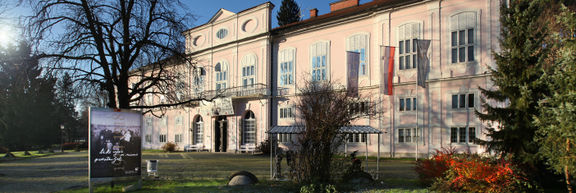National Museum of Contemporary History
-
to
27 Nov 2018
19 Jan 2019
The exhibition In Search of Freedom 1968-2018, prepared by the Beletrina Publishing Institute, National Museum of Contemporary History, The History Meeting House, Warsaw, and EUROM Barcelona, supported by the CMEPIUS - Centre of the Republic of Slovenia for Mobility and European Educational and Training Programmes,
-
to
28 Sep 2018
28 Oct 2018
The exhibition The history revisited. Doctor Mario Cordaro and the artists from Slovenia and Croatia at the concentration camp in Gonars 1942–1943, in cooperation with the National Museum of Contemporary History
-
to
16 Aug 2018
17 Aug 2018
Radio-Television Slovenia (RTV Slovenia) presents three documentary films The Breakthrough at Kobarid, Galician Planes in Blood Bath, and Ozadja prestolonaslednikove smrti, all directed by Valentin Pečenko, featuring Valentin Pečenko and Marko Štepec (National Museum of Contemporary History) as guest speakers, at the scientific symposium World War I Through the Eyes of Poles and Slovenes, supported by the Embassy of the Republic of Slovenia Warsaw,
-
to
17 May 2018
13 Jan 2019
The exhibition What Remains: Traces of Refugees, featuring refugee objects from the National Museum of Contemporary History collection (Being Refugee: A European Narrative project),
-
8 Jun 2016
Museums and their role in the society through the EMEE project, a lecture by Kaja Širok and Urška Purg from the National Museum of Contemporary History,
-
to
18 Jan 2014
20 Apr 2014
The exhibition 1914, organised in the framework of Riga - the European Capital of Culture, featuring works by France Kralj and Tone Kralj (Božidar Jakac Gallery), Fran Tratnik (National Museum of Contemporary History), and Ivan Vavpotič (National Gallery of Slovenia)
The National Museum of Contemporary History is a state museum responsible for the movable heritage of 20th-century Slovene history.
The museum originated as the Scientific Institute of the Executive Committee of the Slovene Liberation Front (IOOF), which was founded in January 1944 in liberated territory. After the war in February 1948 this institution became the Institute for Nationality Questions (Institut za narodnostna vprasanja) and the Museum of National Liberation of the People's Slovenia (Muzej narodne osvoboditve LR Slovenije). In 1952 it was relocated to Cekinov grad, a mid 18th-century Baroque mansion built by Count Leopold Karl Lamberg, and in 1962 it became the Museum of People's Revolution (Muzej ljudske revolucije), a fully-fledged museum with fine art and documentation departments, a photographic department containing more than a million original photographs, conservation and administration departments and a library. During the 1990s the museum once more changed its name, this time to National Museum of Contemporary History.
The museum's collections include weapons, military equipment, numismatics, textiles, medals and decorations, postcards, photographs, films and videos, badges and signs, rubber stamps, seals and printing blocks, philately and cartography. There are displays entitled Terror During World War II, the Partisan Sanitary Service and Printing Houses and Wartime Press 1941-1945, a reconstructed Partisan Workshop and a hand-operated printing works. Of particular note is the permanent exhibition 'Slovenes in the 20th Century', opened in 1996, which illustrates the history of Slovenes from 1914 until the present day. The exhibition presents Slovene economic, political and cultural history in its broadest sense. In addition to turning points in history, such as wars and the foundation of the new state, the exhibition also attempts to illustrate everyday life in historical development. Equipment in the final exhibition room enables visitors to browse the computer database for exhibited objects. By using modern communication or audiovisual technology, the museum also tries to provide visitors with information on material which is not on display,. It is hoped that all documentation will soon be available online.
The museum also prepares exhibitions for overseas touring, for example the exhibition 'The Making of Slovenia', which toured to Dublin in 2002, and the exhibition 'Culture in the National Liberation War', which travelled to Zgonik near Trieste in 2003. An exhibition entitled 'There over the Hills is like here, European Themes of Slovene History', accompanied by multilingual catalogues, is readily available for touring. The borrowing of museum objects and documents is possible in accordance with state regulations.
The museum includes a temporary exhibition area and a lecture room with 30 seats which is suitable for screenings and lectures.
See also
- Branch museums
- Heritage sites
- Libraries




